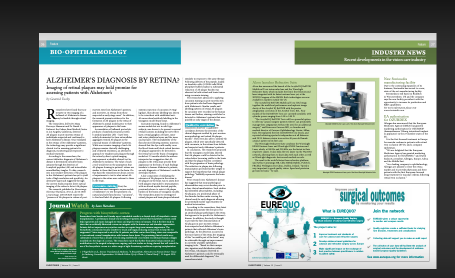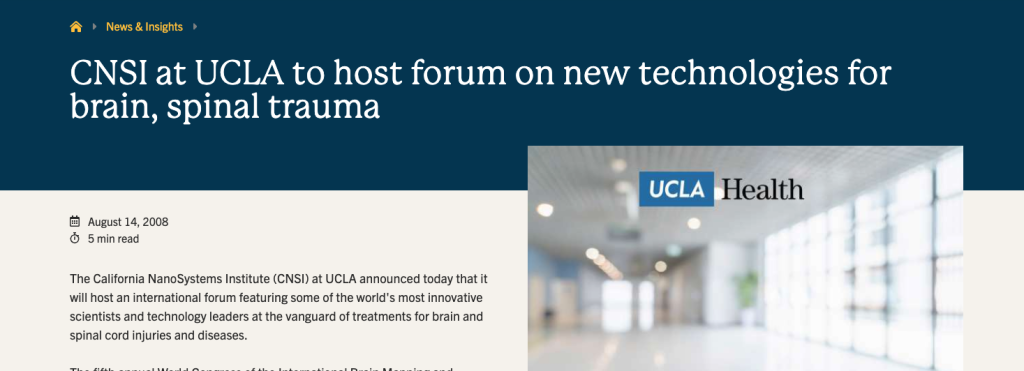Alzheimer’s Diagnosis by Retina? Imaging of retinal plaques may hold promise for assessing patients with Alzheimer’s

Hallmark Alzheimer’s disease changes found in retinas of humans and imaged in live animals

The nerve cell-damaging plaque that builds up in the brain with Alzheimer’s disease also builds up in the retinas of the eyes — and it shows up there earlier, leading to the prospect that noninvasive optical imaging of the eyes could lead to earlier diagnosis, intervention and monitoring of the disease, according to new research. Scientists discovered characteristic amyloid plaques in retinas from deceased Alzheimer’s disease patients and used a noninvasive optical imaging technique to detect retinal plaques in live laboratory mice genetically modified to model the human disease. The combined results suggest the possibility that noninvasive retinal imaging may be helpful in early diagnosis of the disease. The research was conducted by a team of scientists at Cedars-Sinai Medical Center in collaboration with colleagues from the Weizmann Institute of Science in Israel and the University of Southern California. Results were published online June 13 in the journal NeuroImage, and related findings will be presented July 13 at the Alzheimer’s Association International Conference on Alzheimer’s Disease. Alzheimer’s disease is a devastating condition that is becoming more prevalent worldwide as the baby-boom generation advances into its senior years, but there is no conclusive, noninvasive way to diagnose it. Previous studies have suggested that changes in the brain may begin years or even decades before symptoms occur — emphasizing the need for earlier, reliable detection for early therapeutic intervention to achieve effective remedy. The new study suggests the possibility of monitoring Alzheimer’s disease through a simple retinal imaging approach. Abnormal deposits in the brain called beta-amyloid plaques, which damage cells and interrupt cell-to-cell communications, are recognized as a hallmark sign of the disease. However, because existing noninvasive brain-imaging technologies cannot provide sufficient detail about these changes, the most definitive diagnosis of Alzheimer’s disease comes after an autopsy. The research team considered the retina a better target for noninvasive imaging of Alzheimer’s disease because it is readily accessible and, unlike other components of the eye, it is part of the central nervous system, having a direct connection and thus many similarities with the brain. Previous studies have documented non-specific visual disturbances, eye disorders and certain types of retinal abnormalities occurring with Alzheimer’s disease and other neurodegenerative conditions, but this is the first to identify human retinal plaque deposits that could provide a specific diagnostic marker of Alzheimer’s disease. Among the new findings: Together, the results offer the first evidence for the existence of Alzheimer’s-specific plaques in the retina of human patients and the ability to detect individual plaques in live mouse models, creating a strong basis for future research building on these findings. According to the authors, these studies establish the potential of direct retinal beta-amyloid plaque imaging in live subjects as a tool for early Alzheimer’s disease diagnosis and prognosis, as well as assessment of therapies. Specialists in neurosurgery, ophthalmology, imaging systems, neuroimmunology, pathology, neurology and biomedical engineering collaborated on these studies, which were conducted at Cedars-Sinai Medical Center by scientists from Cedars-Sinai, the Weizmann Institute of Science in Israel, and the University of Southern California. The journal article’s first authors are Maya Koronyo-Hamaoui, Ph.D., a research scientist and assistant professor of neurosurgery at Cedars-Sinai’s Maxine Dunitz Neurosurgical Institute and a principal investigator in the Neuroimmunology Laboratory at Cedars-Sinai; and Yosef Koronyo, M.Sc., LL.B., a research associate in the departments of Surgery and Neurosurgery at Cedars-Sinai. Michal Schwartz, Ph.D., visiting professor in the Department of Neurosurgery at Cedars-Sinai, and the Ilze and Maurice Professorial Chair of Neuroimmunology at the Weizmann Institute of Science in Rehovot, Israel, is a senior author. The work was supported by the Marciano Family Foundation, the Maxine Dunitz Neurosurgical Institute, the U.S. Navy Bureau of Medicine and Surgery, the National Eye Institute, the Winnick Family Foundation, and a National Institute on Aging grant to the University of Southern California Alzheimer’s Disease Research Center.
Researchers seek to defeat Alzheimer’s disease by modifying mice’s immune system

Jan 7 2010 WHAT:Using laboratory mice that had been bred to have brain changes similar to Alzheimer’s disease, scientists were able to reduce two characteristic features of the disease by modifying the mice’s immune systems with a special peptide (MOG45D) related to the myelin sheath that insulates nerve cells and nerve fibers. As a result, anti-inflammatory cells were recruited from the blood into the brain, dampening the local inflammatory response. An article published online by the Journal of Neurochemistry describes the immune intervention, its cellular and molecular mechanisms of action, and the effects on disease pathology. WHO:The study was conducted by scientists at the Maxine Dunitz Neurosurgical Institute at Cedars-Sinai Medical Center and the Weizmann Institute of Science in Rehovot, Israel. Michal Schwartz, Ph.D., the article’s senior author, and Maya Koronyo-Hamaoui, Ph.D., first author, are available to provide additional details. Schwartz is visiting professor at the Center of Neuroimmunology and Neurogenesis in the Department of Neurosurgery at Cedars-Sinai Medical Center and professor of neuroimmunology at the Weizmann Institute in Rehovot, Israel. Koronyo-Hamaoui is assistant professor and principal investigator in the Neuroimmunology Laboratory in the Department of Neurosurgery at Cedars-Sinai. DETAILS:The most frequent cause of senile dementia, Alzheimer’s disease is associated with the overproduction of beta-amyloid peptides – molecules that accumulate as sticky deposits in the brain. These “extra-cellular” plaques (accumulating on the exterior of neurons) damage the cells and interrupt cell-to-cell signaling. Abnormal protein tangles (neurofibrillary tangles) inside neurons also lead to cell dysfunction and death. CHEMUK – Highlights from 2022 eBook Compilation of the top interviews, articles, and news in the last year.Download the latest edition Researchers seek to defeat the disease in several ways: by preventing plaque formation; treating existing plaque deposits; and repairing or replacing injured neurons. In this study, scientists modified the cellular and molecular immune environment in the brains of laboratory mice bred to model Alzheimer’s disease with an altered myelin-derived peptide. This recruited anti-inflammatory cells into the brain, which diminished the effects of local inflammatory cells and boosted the action of an enzyme that degrades plaque and is associated with glial scar formation. Source: Cedars-Sinai Medical Center
CNSI at UCLA to host forum on new technologies for brain, spinal trauma

The California NanoSystems Institute (CNSI) at UCLA announced today that it will host an international forum featuring some of the world’s most innovative scientists and technology leaders at the vanguard of treatments for brain and spinal cord injuries and diseases.
